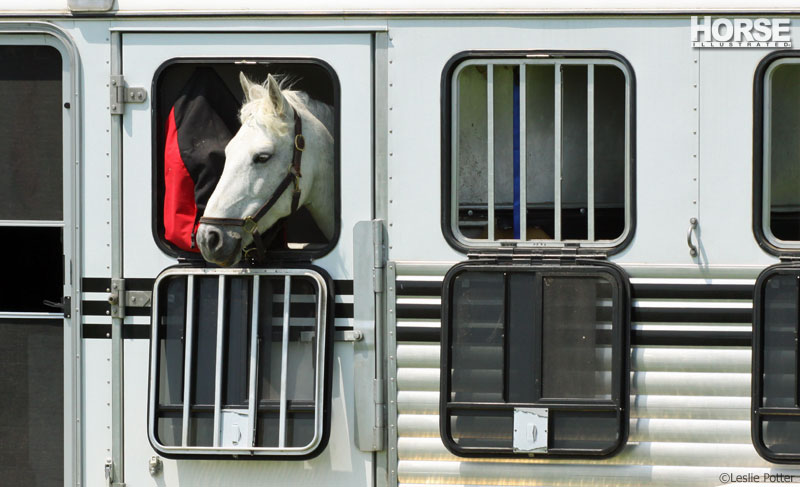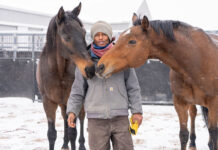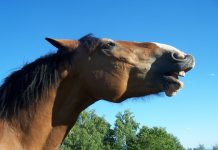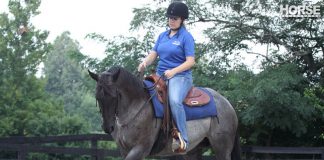
Trailer Loading: Body Language Mistakes
If your horse fights you when the trailer is in view, evaluate your body language and notice what behaviors you may be allowing from your horse. Make sure to avoid the most common problem I see horse owners make: allowing the horse to look away and then turn away from the trailer.
Once you present your horse to the open trailer and walk forward, inviting him to walk in, he should only look and move forward. If you allow him to turn around, you reward his refusal. I’ve seen many horse owners circle their horses around and approach the trailer a second, third and fourth time.
Each time you allow your horse to turn away, you reinforce that looking away and turning away is an option. Only forward motion and looking ahead is allowed.
The other common mistake I see is people who ask the horse to move forward into the trailer but then stand in the doorway and block his ability to move forward. Your horse knows that he isn’t supposed to jump on top of you. If you’re in the way, he doesn’t think that it’s right to go in.
Trailer Loading: The Right Way
What should you do if your horse won’t load up? First, make sure your body language is confident. Lead your horse to the trailer with your arms out so that your hands are in front of the horse and you are gesturing and guiding him forward. You may need to think of straightening your elbows to make sure that you’re not pulling back at all. Make sure your eyes are looking right into the trailer, conveying to your horse that you intend to walk forward and expect him to move with you.
If you know your horse is guilty of looking away, circling, or throwing a fit, prepare for your trailer training session. Outfit your horse in a rope halter and long lead, and make sure you put on gloves.
Safety Note: Never load a horse into a trailer that is not hooked securely to a vehicle, even if you’re only practicing loading. The weight and movement of the horse can easily cause the trailer to move or fall off its chocks.
Rule out escape by correcting your horse for looking around. If he looks away, bump the lead line to turn his nose back toward the trailer so that it stays directly in front of his chest. Always direct your horse’s attention back to the trailer.
You’ll also need to ask a friend to help by holding a training flag behind your horse. If your horse starts to back up, your friend will wave the flag vigorously (in the air, not touching the horse) to apply mental pressure. Your helper should stop waving the instant your horse stops or moves forward.
You’ll make the trailer the safe and easy destination—and moving backward will prove worrisome, but not painful. (Note: Using ropes and whips on the horse’s hindquarters only makes the horse concerned about his rear end; the process doesn’t make him focus on going forward.) You want to reward forward motion by stopping all pressure and allowing the horse to think about moving into the trailer.
Using the flag correctly takes great concentration and impeccable timing. If your timing is off by a second, your horse may not associate the flag’s start and stop with his behavior.
If you’re the one holding the flag, your only job is to stop the horse from backing up. You must watch his feet very closely. Flag vigorously the instant he starts to move back, and stop flagging the instant he moves forward.
The person handling the horse has the job of controlling his nose to stop it from turning right or left. It’s not an easy job and takes a lot of focus. The instant the horse turns his nose to the side, there must be a correction: bumping the lead line to move his nose back to point at the trailer.
As long as the horse is not trying to turn right or left or back up, he can be allowed to stand there and think. I want him to come to the conclusion that his best option is to walk into the trailer.
It’s much better to practice trailer loading when you don’t have to go anywhere. Horses are very good at sensing when you’re in a hurry or are desperate for them to get in. When your horse knows that you’ve got all day, he’s far more likely to give up and get in.
Once he’s had a good training session and is loading well, I may feed him in the trailer twice a day for a week. He’ll come to think of the trailer as a happy place.
Unloading
Some horses may be harder to get out of the trailer than they were to get in—especially if they have to back out. Keep in mind that there is no place in nature where a horse would back down a step.
If you can borrow a trailer that allows you to do so, I advise letting horses walk forward out of a trailer when they’re first learning to load. They will understand the process and where they are.
After a horse is comfortable walking forward out of the trailer, I’ll back him up a few steps in the trailer, then turn him and allow him to walk out forward. I’ll continue to add more and more backing steps until we reach the edge of the trailer.
Work on your in-hand backing skills ahead of time on a level surface away from the trailer. Make sure that your horse will back up one step at a time on your command. Say “back,” then tug backward on the lead line so your horse knows the cue.
Next, practice backing up while your horse is in the trailer. It may take a while, so be patient. If you wait the horse out and convince him that backing out is the only way out, he’ll eventually give it a try.
He may step down then jump back in, so be prepared and stay out of the way. With lots of praise, understanding and patience, he’ll figure it out.
Trailer Tying
Never tie your horse inside the trailer until the divider or door is shut and he’s safely enclosed. If you tie before the door is shut, your horse may panic and pull back on the rope. He could get his hind legs out and under the trailer while his head is still tied. This can result in horrible injuries.
Likewise, untie the horses before opening any doors. Most horses are eager to get out of the trailer and they know the sound of the door opening. In a straight-load trailer, make sure the butt bar is down before opening the door. If the horse panics to get out, you don’t want him to get under the bar. Open any door slowly and close it immediately if it appears the horse is going to panic to get out.
I like to tie and untie my horse without getting into the same compartment that the horse is in. The best scenario is if I can reach into the trailer and untie the rope from outside the window.
If you use trailer ties, make sure the quick release is on the tie end, not at the horse’s head. If I need to release it in an emergency, I’d like the lead to be on the horse instead of attached to the trailer.
I always tie while trailering because it’s not hard for an untied horse (or a horse tied too long) to turn his head around and then not be able to turn back. The rope should be at a length so that the horse can hold his head in a relaxed, wither-height position, but no looser.
This article about Julie Goodnight Trailer Loading originally appeared in the July 2018 issue of Horse Illustrated magazine. Click here to subscribe!






